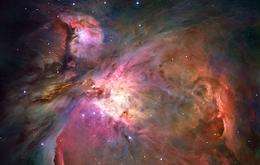Astronomers Witness a Star Being Born

(PhysOrg.com) -- Astronomers have glimpsed what could be the youngest known star at the very moment it is being born. Not yet fully developed into a true star, the object is in the earliest stages of star formation and has just begun pulling in matter from a surrounding envelope of gas and dust, according to a new study that appears in the current issue of the Astrophysical Journal.
The study's authors—who include astronomers from Yale University, the Harvard-Smithsonian Center for Astrophysics and the Max Planck Institute for Astronomy in Germany—found the object using the Submillimeter Array in Hawaii and the Spitzer Space Telescope. Known as L1448-IRS2E, it's located in the Perseus star-forming region, about 800 light years away within our Milky Way galaxy.
Stars form out of large, cold, dense regions of gas and dust called molecular clouds, which exist throughout the galaxy. Astronomers think L1448-IRS2E is in between the prestellar phase, when a particularly dense region of a molecular cloud first begins to clump together, and the protostar phase, when gravity has pulled enough material together to form a dense, hot core out of the surrounding envelope.
"It's very difficult to detect objects in this phase of star formation, because they are very short-lived and they emit very little light," said Xuepeng Chen, a postdoctoral associate at Yale and lead author of the paper. The team detected the faint light emitted by the dust surrounding the object.
Most protostars are between one to 10 times as luminous as the Sun, with large dust envelopes that glow at infrared wavelengths. Because L1448-IRS2E is less than one tenth as luminous as the Sun, the team believes the object is too dim to be considered a true protostar. Yet they also discovered that the object is ejecting streams of high-velocity gas from its center, confirming that some sort of preliminary mass has already formed and the object has developed beyond the prestellar phase. This kind of outflow is seen in protostars (as a result of the magnetic field surrounding the forming star), but has not been seen at such an early stage until now.
The team hopes to use the new Herchel space telescope, launched last May, to look for more of these objects caught between the earliest stages of star formation so they can better understand how stars grow and evolve. "Stars are defined by their mass, but we still don't know at what stage of the formation process a star acquires most of its mass," said Héctor Arce, assistant professor of astronomy at Yale and an author of the paper. "This is one of the big questions driving our work."
More information: DOI: 10.1088/0004-637X/715/2/1344
Provided by Yale University



















